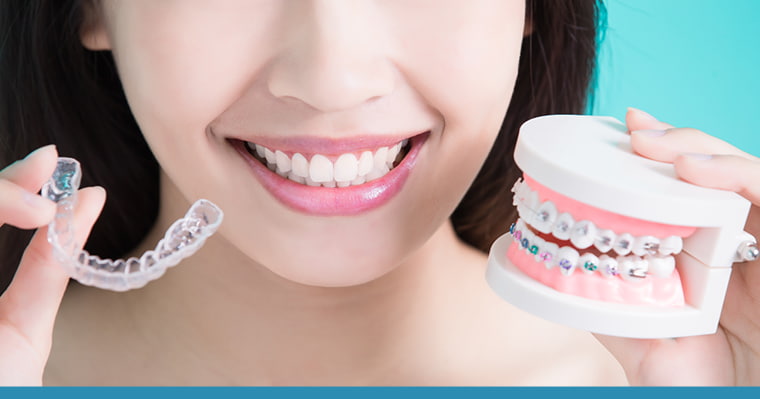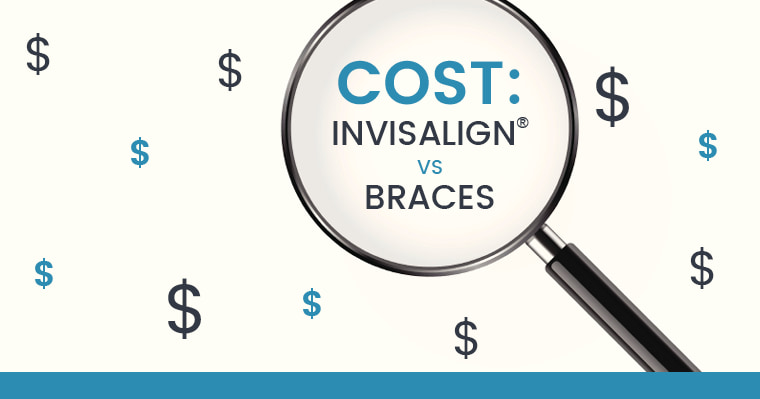
First, if you're asking yourself this question,
give yourself a pat on the back.
Comparing orthodontic options means you are taking the first step toward a beautiful, straight smile. Or perhaps you're doing research for your child or loved one. Either way, great news!
Having straight teeth will not only
look great and make you more confident, but it will also improve your oral and overall health.
So:
How do you know which orthodontic option is better, Invisalign® or braces?
Our dentist in Seattle,
Dr. Azary, and his team have outlined
the differences - and yes, similarities - of Invisalign® and braces in this blog. Compare the two and then decide which is the better option for you.
The clear difference between Invisalign® vs. braces
Probably
the biggest reason patients chose Invisalign® over braces is the difference in appearance.
It's no secret that wearing orthodontic appliances isn't ideal, so having a discreet way to align your teeth can make the process a bit more enjoyable for some.
Here's more on the visible difference of Invisalign® vs. braces:
Invisalign®: With Invisalign® treatment, you’ll wear
clear, plastic aligners over your teeth. These trays are virtually invisible and people may not even notice you are wearing them.
Depending on your treatment plan, you may need small, tooth-colored attachments on your teeth, which help the aligners move your teeth. These attachments are hardly noticeable too.
If you don’t want to disrupt your social life with orthodontics, then Invisalign® may be a great option.
Braces: Braces have come a long way in recent years, offering
different options such as traditional metal braces and tooth-colored ceramic braces.
Braces consist of a bracket on each tooth and a wire connecting them. For this reason, braces are more noticeable. However, with ceramic braces, that can be minimized.
Patient compliance
Another big difference between Invisalign® and braces is
the removable factor. Aligners can be removed by you at any time, whereas braces are adhered to your teeth and must be removed professionally.
Why this plays a big role:
Invisalign®: To stay on schedule, you will need to wear your aligners for at least 20 hours a day. This means you can only take them off to eat, drink, brush, and floss.
Not wearing them enough can delay your treatment and cause discomfort. This is why Invisalign® is only suitable for teenagers and adults.
A perk of having removable aligners is that you can still eat and drink what you want without getting food stuck or threatening to damage your orthodontic appliances.
Braces: Because they cannot be removed, braces work 24/7 to gradually move your teeth into their proper position. For some, this is reassuring because there’s no chance of not wearing them enough and delaying progress.
Braces are a good option if you lack self-discipline or are afraid you will lose the aligners. Many patients choose braces for their children because of these reasons.
Cost difference between Invisalign® and braces

You would be surprised to know that typically, there isn’t a big cost difference between Invisalign® and braces. The
average cost for both is $5,000 - although that can be less or more depending on your unique situation.
To find out exactly how much Invisalign® in Seattle would cost you,
schedule a consultation with our dentist, Dr. Azary.
A separate cost-related factor to consider is time and transportation:
Invisalign®: You will be given a few sets of aligners at a time and can change those at home, roughly every two weeks. You will only get check-ups approximately every six weeks.
Braces: To adjust your braces and keep your teeth gradually moving, you will have more frequent check-ups.
If you don’t follow the recommended guidelines for braces, like avoiding certain foods and wearing mouthguards while playing sports, then you could damage your brackets or wires, which requires more trips to the dentist or orthodontist.
Effectiveness of Invisalign® vs.braces
Depending on your situation, both Invisalign® and braces may be equal contenders.
Here’s how they square up:
Invisalign®: With proper patient compliance, the average treatment time for
Invisalign® in Seattle is 12 months. These aligners can fix:
- Overly crowded teeth
- Gapped teeth
- Crooked teeth
- Underbites
- Overbites
- Crossbites
Braces: In addition to the list above, braces are best used to fix complex cases. Teeth that are severely misaligned or crooked benefit from the permanent, secure brackets of braces.
Which is better, Invisalign® vs. braces?
If you are a candidate for both Invisalign® and braces, then
the best option is going to be up to you. Clearly, there are some differences, and what some people love about one option, other people may dislike.
If you're interested in a clear, discreet way to straighten your teeth, then
contact us today!
During your Invisalign® consultation at
Love Your Smile, you can
review your potential smile outcome before you even start! Together with Dr. Commons, you will discuss your smile goals and create a treatment plan, which will outline Invisalign® costs.
 First, if you're asking yourself this question, give yourself a pat on the back.
Comparing orthodontic options means you are taking the first step toward a beautiful, straight smile. Or perhaps you're doing research for your child or loved one. Either way, great news!
Having straight teeth will not only look great and make you more confident, but it will also improve your oral and overall health.
So:
How do you know which orthodontic option is better, Invisalign® or braces?
Our dentist in Seattle, Dr. Azary, and his team have outlined the differences - and yes, similarities - of Invisalign® and braces in this blog. Compare the two and then decide which is the better option for you.
First, if you're asking yourself this question, give yourself a pat on the back.
Comparing orthodontic options means you are taking the first step toward a beautiful, straight smile. Or perhaps you're doing research for your child or loved one. Either way, great news!
Having straight teeth will not only look great and make you more confident, but it will also improve your oral and overall health.
So:
How do you know which orthodontic option is better, Invisalign® or braces?
Our dentist in Seattle, Dr. Azary, and his team have outlined the differences - and yes, similarities - of Invisalign® and braces in this blog. Compare the two and then decide which is the better option for you.
 You would be surprised to know that typically, there isn’t a big cost difference between Invisalign® and braces. The average cost for both is $5,000 - although that can be less or more depending on your unique situation.
To find out exactly how much Invisalign® in Seattle would cost you, schedule a consultation with our dentist, Dr. Azary.
A separate cost-related factor to consider is time and transportation:
Invisalign®: You will be given a few sets of aligners at a time and can change those at home, roughly every two weeks. You will only get check-ups approximately every six weeks.
Braces: To adjust your braces and keep your teeth gradually moving, you will have more frequent check-ups.
If you don’t follow the recommended guidelines for braces, like avoiding certain foods and wearing mouthguards while playing sports, then you could damage your brackets or wires, which requires more trips to the dentist or orthodontist.
You would be surprised to know that typically, there isn’t a big cost difference between Invisalign® and braces. The average cost for both is $5,000 - although that can be less or more depending on your unique situation.
To find out exactly how much Invisalign® in Seattle would cost you, schedule a consultation with our dentist, Dr. Azary.
A separate cost-related factor to consider is time and transportation:
Invisalign®: You will be given a few sets of aligners at a time and can change those at home, roughly every two weeks. You will only get check-ups approximately every six weeks.
Braces: To adjust your braces and keep your teeth gradually moving, you will have more frequent check-ups.
If you don’t follow the recommended guidelines for braces, like avoiding certain foods and wearing mouthguards while playing sports, then you could damage your brackets or wires, which requires more trips to the dentist or orthodontist.